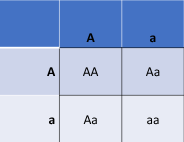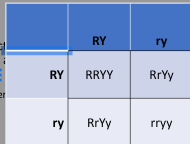CHapter 9 dihybrid crosses
1/9
There's no tags or description
Looks like no tags are added yet.
Name | Mastery | Learn | Test | Matching | Spaced |
|---|
No study sessions yet.
10 Terms
monohybrid cross
A cross between two individuals that are heterozygous for one character is called a monohybrid cross.
Mono – one.
Hybrid - a thing made by combining two different elements (in this case, heterozygous)
Result:
1 homozygous dominant
2 heterozygotes
1 homozygous recessive

monohybrid cross
For complete dominance, this leads to a phenotype ratio of 3:1 (3 dominant individuals for every 1 recessive individual)
A - Orange flowers; a – purple flowers
A monohybrid cross of two Aa individuals will result in
3:1 orange:purple in the offspring.

dihybrid cross
is a cross between two organisms that are each heterozygous for two characters
Di – two
Remember, the law of independent assortment applies here. Each character (gene) is independent of the other.
Think about this scenario
If the two genes were linked (not independent) what gametes could F1 individuals make?
RY would stay together (because they came
from the same parent) and ry would stay togetherRY and ry
You would then predict the
outcome of that cross as:3:1 ratio
3 yellow round for every
1 green and wrinkled
Think about this scenario

for independent assortment, the genes inherited from a parent don’t have to stay together in the gametes for the next generation.
RrYy individuals can make 4 different
types of gametes:RY, Ry, rY, ry
Every possible combination of one allele for
each geneFOIL (first, outer, inner, last)
A dihybrid cross requires a 4x4 Punnett square!
Dihybrid Cross: RrYy x RrYy
For a dihybrid cross showing complete dominance, you get a ratio of 9:3:3:1.
9 dominant for both traits (yellow, round)
3 dominant for the first and recessive for the second (yellow, wrinkled)
3 recessive for the first and dominant for the second (green, round)
1 recessive for both traits (green, wrinkled)
Test cross
A mating between an individual of unknown genotype and a homozygous recessive individual.
Why?
Because it will reveal any recessive alleles in the unknown individual.
Practical use: breeding
B – black fur
b – brown fur
Back Cross (test cross)
A breeding technique for getting new traits into a line without losing existing traits.
Imagine a fancy rose. It’s gorgeous and has a pleasant smell, but it’s also very frail.
You decide to cross Fancy Rose with a hardier species: Hardy Rose.
The offspring are stronger, but not as pretty.
So you cross the offspring with another Fancy Rose. (original parent or an individual genetically similar/identical)
The goal is to incorporate new traits without losing the old traits.
Test cross
By function
Testcross is to determine the genotype of an individual with a dominant phenotype.
Backcross is to incorporate new characters into an existing genetic line with minimal loss of desired traits.
by process
Backcross is crossing the offspring with a parent or an individual with a similar/identical genotype to the parent.
Testcross is crossing the individual of interest with a recessive individual.